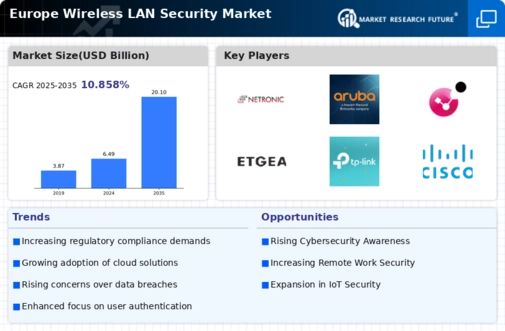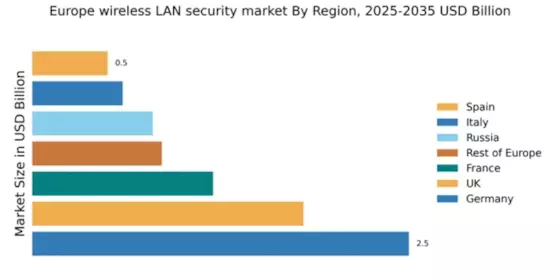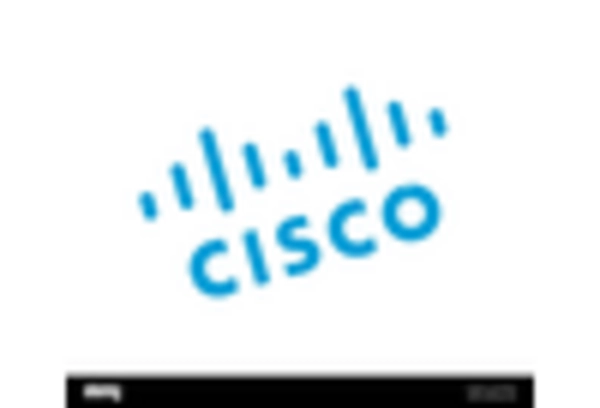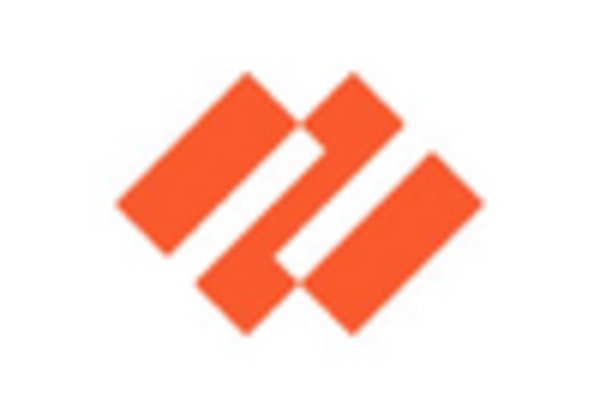Rising Cybersecurity Threats
the wireless LAN security market in Europe is experiencing heightened demand due to the rising frequency and complexity of cyber threats.. Organizations are compelled to invest in robust security measures to protect sensitive data and maintain compliance with regulations. In 2025, it is estimated that cybercrime could cost European businesses over €200 billion annually, underscoring the urgency for enhanced wireless security solutions. This trend is likely to drive growth in the wireless lan-security market as companies seek to mitigate risks associated with data breaches and unauthorized access. The need for advanced encryption protocols and secure access points is becoming paramount, leading to a surge in the adoption of innovative security technologies.
Increased Remote Work Adoption
the wireless LAN security market in Europe is undergoing a transformation due to the increase in remote work.. As organizations embrace flexible work arrangements, the need for secure wireless networks has become more critical than ever. A recent survey indicates that over 60% of European companies have adopted hybrid work models, necessitating robust security measures to protect remote access to corporate networks. This shift is likely to propel the demand for advanced wireless security solutions, including Virtual Private Networks (VPNs) and secure access controls. Consequently, businesses are investing in technologies that ensure secure connectivity for remote employees, thereby driving growth in the wireless lan-security market.
Growing Awareness of Data Privacy
the wireless LAN security market in Europe is increasingly influenced by heightened awareness of data privacy among consumers and businesses.. As individuals become more conscious of their digital footprints, organizations are compelled to prioritize data protection in their wireless security strategies. This shift is evident in the rising demand for solutions that ensure data integrity and confidentiality. In 2025, it is anticipated that investments in data privacy technologies will increase by 20%, reflecting the urgency to safeguard personal information. Consequently, businesses are adopting comprehensive wireless security measures to build trust with customers and comply with evolving privacy standards, thereby driving growth in the wireless lan-security market.
Regulatory Compliance Requirements
the wireless LAN security market in Europe is strongly affected by strict regulatory frameworks designed to protect personal data and ensure cybersecurity.. Regulations such as the General Data Protection Regulation (GDPR) mandate organizations to implement adequate security measures for wireless networks. Non-compliance can result in hefty fines, reaching up to €20 million or 4% of annual global turnover, whichever is higher. As businesses strive to adhere to these regulations, the demand for comprehensive wireless security solutions is expected to rise. This regulatory landscape not only drives investment in security technologies but also fosters a culture of accountability and vigilance within organizations, thereby enhancing the overall security posture.
Technological Advancements in Security Solutions
the wireless LAN security market in Europe is gaining from rapid technological advancements that improve security capabilities.. Innovations such as next-generation firewalls, intrusion detection systems, and AI-driven security analytics are becoming integral to wireless security strategies. These technologies not only improve threat detection and response times but also reduce the overall cost of security management. In 2025, the market for advanced security solutions is projected to grow by 15%, reflecting the increasing reliance on sophisticated technologies to combat evolving threats. As organizations seek to leverage these advancements, the wireless lan-security market is poised for substantial growth, driven by the demand for cutting-edge security solutions.


















Leave a Comment